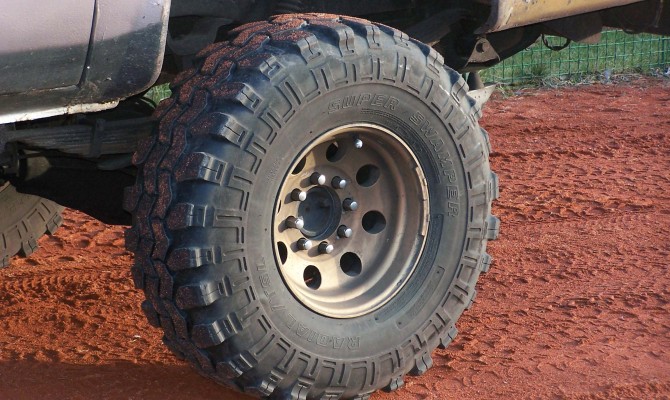“Having good traction tires helps off-roaders get to where they need to go without being stuck…”
Driving down a gravel road to get to your favorite fishing hole or a day out with your family brings lots of enjoyment.
Getting there requires proper tires. Rocks, potholes, and rough terrain all play are part on how your tires perform.
The main function of any tire is to provide traction. Having good traction tires helps off-roaders get to where they need to go without being stuck. When shopping for an off-road/on road tire there are a few things to consider. Cheap tires are not the best option because “you get what you pay for” definitely applies here.
Some things to consider are high mileage tires and tread wear ratings. Some aggressive mud tires tend to wear a lot quicker than an all-terrain tire.
The next thing to consider is tire size. You can contact the manufacturer or check tire charts that give you variety of sizes to fit your vehicle. The height of your sidewall is important and should be chosen based on the conditions where you drive your truck most often.
If you only drive on the street then a low profile truck tire will be fine, but if you go off-roading then you are going to want more tire in between your rim and the ground. That way you will not bottom out on the rims when the tires encounter rough terrain off-road.
The size of the rim is a personal preference. Popular today are the larger sized rims. Just make sure that the rim and truck tire you choose will fit inside the wheel well of the truck, and don’t forget to upgrade your brakes to help stop this increase in weight.
The Wheel Rim width varies from truck to truck. It can be custom made to suit both on and off road driving conditions. The wheel rim width is rounded off to the nearest half inch of the tire. Usually, the best choice is to have the rim width at about 90 percent of the tread width of the tire. Adequate air pressure is important for a good tire life, handling, and traction. Look through your truck’s owner’s manual, on the sticker inside the driver’s door, or look on the tire itself to find the correct air pressure that you need to maintain them.
Seasonal changes can affect the air pressure of the tires. Cold temperatures are responsible for dropping the air pressure of the tires, and warm temperatures are responsible for increasing the air pressure. A 10 percent swing in the temperatures causes a 1lb. change in the air pressure. Sudden changes in temperature are a good time to check the pressure of the tires.
You can reduce the wear and tear of the truck’s tires by rotating them often. Rotating the tires, keeps the tread wear balanced and can really help when slippery and wet conditions occur. A simple rule about rotating your tires is to do it on every other oil change. Doing this consistent basis, will make the tires last longer and allow a comfortable ride for many, many kilometres.
Recent Comments
- { Enjoyed your Forest of Bowland in the BMW X5M, particularly the photo of the BMW in front of the main part of Stonyhurst College where... }
- { Bantam designed the Jeep, not Willy's or Ford. The American military gave the original Bantam prototype to Willys and Ford to copy. There is plenty... }
- { All Escalades come with a 6.2-lilter V8 engine that produces 420 horsepower. A six-speed automatic is the only transmission offered and drives the rear wheels.... }
- { Alexandra is an excellent journalist. }
Popular Posts
- Journey to a ‘Sparkling’ Luxury Okanagan Resort “Four lucky readers will put a Dodge Journey’s weekend-...
- The Need For Speed: Hike Those Highway Limits More than half of those polled believe the province sho...
- Drives-U-Crazy… Erratic drivers. An early morning drive from Kelowna to Vancouver is nor...
- Readers Respond: The Pros and Cons of Increasing B.C. Speed Limits Increasing the speed limits will only increase risk to...
- Honda CR-V Review: The Compact Crossover To Get Things Done The CRV is a very stylish and aerodynamic crossover veh...







